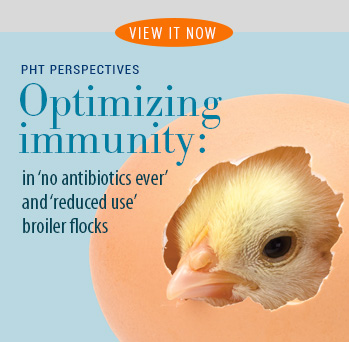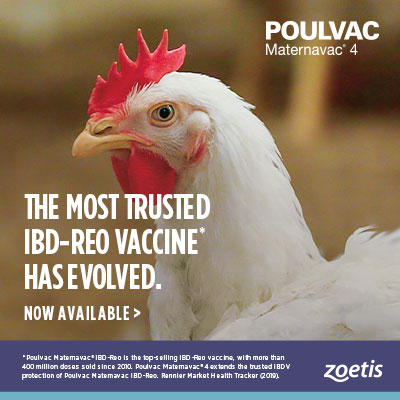As seasons change, hatchery ventilation is key chick-quality concern

An interview with Chris Williams, PhD, director, technical services devices, Zoetis
Q: Every fall and winter, the poultry industry faces specific production challenges, but why is ventilation such a pivotal part of that?
CW: The environment that we’re incubating eggs in changes from cooling in the summer to heating in the fall and winter, which brings air volume and humidity control changes. That can affect incubator and hatchery operation and therefore population uniformity and chick quality.
Couple these environmental issues with stressors that affect immune system development — like how much yolk is utilized in development, which is directly correlated to day-old-chick maternal antibody levels — and we end up with a mixed bag of challenges. We’ll see things like runting and stunting, reovirus or infectious bronchitis disease that may all be linked back to what we were doing with ventilation and incubation.
Q: What’s the importance of hatchery air pressure in maintaining effective ventilation?
CW: Pressure is important to the function of the incubation equipment and to the overall hatchery biosecurity. In the T-design hatchery, incubators and egg rooms have a positive airflow; they are pushing air to the rest of the hatchery. This is so important for your hatchery, especially in wintertime. Just as important are negative airflow areas — the pull room and truck bays.
Q: Assuming you have a basic understanding of what ventilation the building requires, that brings us to seasonal differences. What are the key considerations in the warmer months?
CW: In the summer, you’re cooling and dehumidifying. You have a lot of fresh air and pretty consistent pressure controls through dampers and exhaust systems. This is natural humidification; we’re not having to add humidity. Fresh air has a sanitizing effect. At this time, you need to pay attention to condensation-pan drainage of your HVAC systems, which can be a reservoir for fungal and bacterial growth. You need to make sure that they’re flowing and have an eye on their cleanliness, as well as routinely flushing and disinfecting.
Q: As nights cool, what are the primary risks to think about?
CW: When we go from air conditioning to heating, there are microbial challenges. Any fungal activity in those condensation pans starts drying out. When fungus dries, it goes through a sporulation cycle, so fungal spores are going to be coming into your building. You need to make sure you inspect your HVAC units and get things clean.
Remember that our change from dehumidification and cooling in the summer to adding humidification in the winter with heating changes the quality of that humidity, as well as the bacterial and fungal load and dispersion.
Q: Factors such as hatchery location can present challenges with incoming-air quality. What are the steps to mitigate such issues in the fall?
CW: Get on the roof and inspect your HVAC units. Make sure the air pathway is clean from air intake to fan and housing. Check the fit of fresh-air exchange filters, the fan blades and the trunks of units as they come into the hatchery as well as condensation and bottom pans.
Make sure any supportive heating equipment gets a good cleaning. Heaters (Reznor or similar) can be a tremendous dispersal unit for fungus. Consider the type of insulation. Fiber insulation can be very hard to clean. Insulation inside the unit should be either isolated from the air pathway with an enclosure or be the type that can be cleaned.
Although you’re not going to use evaporative cooling in your pull room or hallways during cold weather, you can use it to fulfill fresh-air requirements in wintertime. Clean out the water pans underneath and clean or replace the cooling pads.
Q: During colder months, what are the main ventilation considerations in egg storage areas?
CW: Condensation and mold growth are concerns. Make sure you have good, clean air flow pathways and circulating capability in the room itself. Large ceiling fans work well in the egg room and help prevent segmented temperatures. We need to get uniformity of temperatures throughout the room.
Q: Can you give any examples of how “tweaks” to a ventilation system have solved problems in the hatchery?
CW: There was a case where the pull-room exhaust was causing recirculation of fluff into the HVAC roof-top ventilation system, leading to a huge mold problem. The pull-room exhaust ductwork was altered so that it went into a large collecting tank that had disinfected water in the bottom. That really helped the situation. The collection tank was easily drained and cleaned daily after each pull.
Q: Zoetis has been taking thousands of microbial samples from hatcheries as it introduced and supported in ovo vaccination to the industry, allowing for the assessment of ventilation and sanitation. What have you found?
CW: There are inherent risks of fungal challenge with in ovo vaccination. That’s not to say there’s no risk without it, but it’s more evident and observable during unhatched-egg necropsy or break out. We have found key areas that need attention as well as the ventilation that supplied those areas. We use the data we gather to develop a risk assessment based on six areas of the hatchery, and we do this based on positive identification of Aspergillus and its relative concentration in these areas.
Aspergillus is an opportunistic pathogen which is carried by the air. When inhaled by the baby chick it causes an immune response and congestion in the chick’s lungs. We use the level of Aspergillus found to assess how well we’re doing in our sanitation and biosecurity programs, with an overall score ranging from no Aspergillus challenge (score of 10) to extremely high level of Aspergillus challenge with a score of 50.
We know from experience that if the score is 30 or less, we have very good control of sanitation in the ventilation system. With a score of 30 to 39, there’s a moderate risk for fungal mycosis. And if you’re score is over 40, we have a high risk for chick health issues. Our technical services team works with each individual hatchery and situation to tailor remediation steps and help identify corrective measures to remove those challenges.
All trademarks are the property of Zoetis Services LLC or a related company or a licensor unless otherwise noted.
TOOLBOX, Issue 26
Toolbox is a series of interviews with veterinarians and other technical specialists about their experiences managing antimicrobials, vaccines and other tools for poultry health. It is produced by the editors of Poultry Health Today on behalf of the US Poultry Business of Zoetis.
POU-00180
Sep 2021
Posted on January 4, 2022
 We’re glad you’re enjoying
We’re glad you’re enjoying















